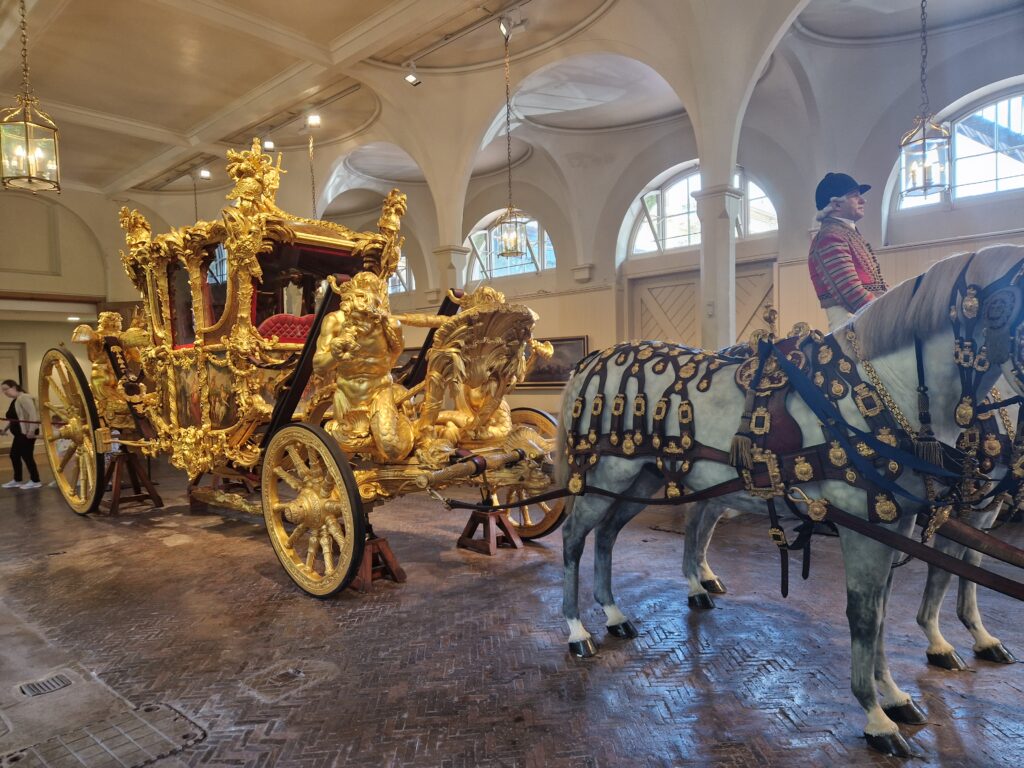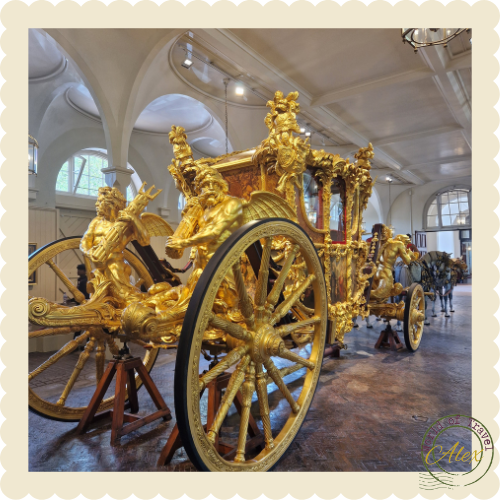How to visit The Royal Mews at Buckingham Palace, London
If you are planning to visit The Royal Mews at Buckingham Palace, London, here is everything you need to know.

Plan your visit
The Royal Mews at Buckingham Palace oversees all road travel arrangements for The King and the Royal Family, managing everything from horse-drawn carriages to modern vehicles and even attire.
This museum is incredibly enjoyable, and great fun for children. You receive an informative audio guide that leads you through the exhibition, providing insights into the various coaches in the collection.
There are also plenty of engaging activities for children, including drawings, opportunities to sit in a coach, and trying on livery. The tour is not too lengthy, allowing you to explore at your own pace.
History of the Royal Mews
The Royal Mews, now within Buckingham Palace’s gardens since 1825, has a rich history dating back to Richard II’s reign in the late 14th century. For about a century, it resided at Charing Cross, today’s National Gallery site, from Richard II to Henry VII.
The name ‘Mews’ originates from the royal hawks once housed there. ‘Mew’ means moulting, and these birds were kept in a ‘mews’ during this process. A fire during Henry VIII’s reign in 1534 led to the building’s reconstruction as stables, though it retained the name ‘Mews’ despite its new function.

The Royal Mews today
The Royal Mews provides transportation for The King and the Royal Family, utilizing horse-drawn carriages and motor cars. It also trains horses for carriage duties during important events. The Royal Mews maintains state carriages, coaches, and cars for ceremonies such as coronations, the State Opening of Parliament, and visits by foreign dignitaries.
Approximately 50 times a year, their carriages transport newly appointed high commissioners and ambassadors to Buckingham Palace for credential presentations. Since 1843, the messenger Brougham carriage has handled daily post runs between Buckingham Palace and St James’s Palace. The Diamond Jubilee State Coach, a recent addition, commemorates Queen Elizabeth II’s Diamond Jubilee.


The Gold State Coach
The Gold State Coach, a historic British treasure crafted in 1762 for royal transport, has been a fixture at coronations, jubilees, and regal events for 260 years. Designed by William Chambers and created by coachmaker Samuel Butler, this opulent giltwood coach boasts an interior adorned with luxurious velvet, satin, and ornate panels depicting Roman deities.
Its grandeur is further enhanced by gilded sculptures, including cherubs representing England, Scotland, and Ireland on the roof, as well as massive triton figures above each wheel. Weighing four tonnes and measuring seven meters in length and 3.6 meters in height, it requires eight horses to pull and is limited to a walking pace due to its age and weight.
Queen Elizabeth II used it during her 1953 Coronation Day, with a hot water bottle placed under the seat to combat unseasonably cold and wet weather. In 2022, it featured a hologram of Queen Elizabeth II in the windows for the Platinum Jubilee Pageant.
While George III, George IV, and William IV used the coach for State Openings of Parliament, Queen Victoria rarely employed it after Prince Albert’s death in 1861. In the UK, only two coaches are older: the Speaker of the House of Commons’ Coach from 1698 and the Lord Mayor of London’s Coach built in 1758.



The Diamond Jubilee State Coach
The Diamond Jubilee State Coach, used during King Charles III’s Coronation in 2023, is a grand vehicle measuring over 5 meters in length, weighing more than 3 tonnes, and requiring six horses for its propulsion. Originating from Australia, it seamlessly combines traditional craftsmanship with modern technology, featuring an aluminum body stabilized by six hydraulic supports to prevent swaying.
Notable components include seat handrails from the Royal Yacht Britannia, while window frames and interior panels incorporate samples from iconic locations.
Furthermore, the coach contains historical pieces such as a fragment from a Battle of Britain Spitfire, a Hawker Hurricane, and an Avro Lancaster from 617 Squadron, as well as a .75 British musket ball from the Battle of Waterloo. It also houses digital copies of Magna Carta and Domesday Book.
At the top of the coach, a gilded crown carved from oak sourced from HMS Victory serves as a platform for a camera to record journeys.


Accessibility and facilities
Upon arrival, expect an airport-style security check. The Royal Mews have a multimedia guide, lasting about 45 minutes. It’s available in multiple languages, including versions for families, D/deaf and hard of hearing visitors, and an audio-descriptive guide for the visually impaired.
Restrooms, Changing Space, and baby-care facilities are adjacent to the large State Coach House.
You can bring pushchairs into the Mews. The entire Royal Mews is accessible, but it is a historic building with uneven and cobbled floors.
The tour ends through the Royal Mews shop with is a good size and you can have a nice look around.
Public transport
Train: The closest train stations are London Victoria (a 10-minute walk) and London Charing Cross (a 20-minute walk).
Underground: The nearest tube stations are Victoria, Green Park, St. James’s Park, and Hyde Park Corner, all approximately a 10-minute walk.
Bus: Bus numbers 11, 211, C1, and C10 stop on Buckingham Palace Road. Additionally, Victoria Coach Station is just a 10-minute walk from the Palace.


Tickets
Adult £15
18-24 years £10
Child 5-17 and Disabled £9
Children under 5 for free
Opening times
From March 2 to October 30, 2023, the Royal Mews is open daily from 10:00 AM to 5:00 PM.
Please note that it is closed on Tuesdays and Wednesdays.
Dates for 2024 are yet to be released.
